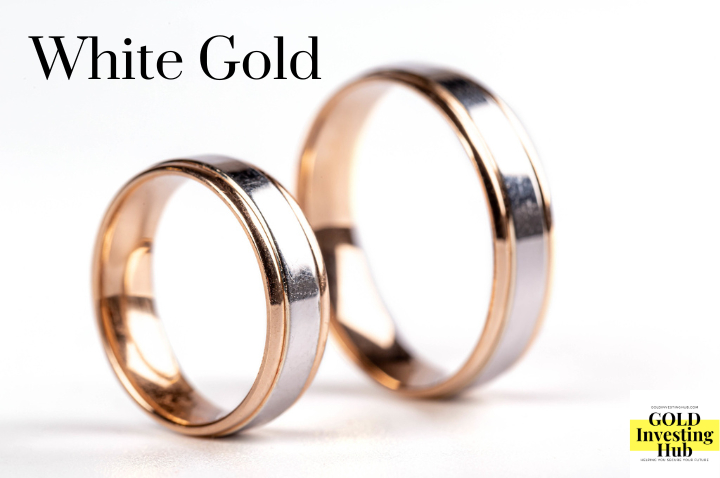Although white gold is a common choice for jewelry, many people are unaware of its composition. Look at white gold's characteristics, what white gold is made of, and how it differs from those of yellow gold.
Pure yellow gold is combined with other metals to create an alloy that is tougher and has a white hue to create white gold.
Usually, palladium, silver, nickel, copper, and zinc are the other metals that can be included in white gold.
While the hue of gold in its purest form is yellow, it is also available in white and rose gold alloys.
Pure gold is 24 Karats, but because it is brittle, other metals are mixed in to make it more durable.
Contents
The amounts of the metals included determines how white the alloy turns out, which is why certain pieces of white gold tend to be more white than others and have a stronger yellow hue.
The family of platinum metals includes rhodium. Its tint is a silvery white and it is hypoallergenic and durable.
Silver and white gold are frequently plated with rhodium to give them a "white" appearance, offer a hypoallergenic coating, and stop silver from corrosion.
This coating may eventually come off, especially if the item is used frequently or is exposed to chemicals from cosmetics or fragrances.
To maintain the piece's brand-new and immaculate appearance, this coating may be effortlessly reapplied by a jeweler.
White gold is manufactured from genuine, pure gold despite the use of alloy elements. By examining the hallmark, you can determine whether the white gold jewelry you own is made of genuine gold.
White gold is essentially a matter of personal preference. Overall, if you adore the neutral, timeless aesthetic of silver or platinum, it makes for a lovely purchase.
Although it is less expensive than platinum if you're on a tight budget, it is significantly more valuable and durable than silver.
White gold has surpassed traditional yellow gold in popularity over the past 50 years and is now the most often selected metal for engagement rings. This confirms its modern, adaptable appearance, outstanding value, and premium feel.
The most substantial and lasting precious metal is platinum, which is heavier and denser than gold.
Platinum is typically alloyed with base metals when jewelry is made, and it must have a minimum of 50% platinum to be considered "Platinum Jewelry."
Platinum is rarer than any other metal used to make jewelry, hypoallergenic, and associated with status.
Gold and platinum are equally expensive per gram, however, due to platinum's density, jewelry made of platinum will weigh more and hence be more expensive overall.
In other words, The initial distinction between white gold and platinum is the most fundamental and serves as the basis for all subsequent distinctions.
Platinum and white gold are two distinct metals. White gold is initially made of gold. Gold is yellow.
Platinum is a white metal by nature. Platinum and white gold each have distinctive qualities that set them apart.
Platinum is a white metal by nature. It doesn't require alloying to give it color.
90% to 95% platinum and the remaining alloy make up the average composition of jewelry platinum. As an alloy hardener, iridium or ruthenium are frequently used.
Even the best white gold contains a trace of yellow. Platinum, which is a grey white, will maintain its color.
The poor mixes are a significant issue for white gold. White gold that is manufactured by certain companies looks pale yellow and never appears white.
It does not appear to be a major issue because you may choose not to purchase a product if you do not like the light yellow appearance of that manufacturer.
Rhodium, a silver-white metal similar to platinum, is typically used as a strong protective coating for new white gold rings.
Rhodium plating is used to enhance the whiteness of white gold. Although exceedingly white and sturdy, rhodium gradually loses its hardness.
The quality of the white gold is first revealed as the rhodium fades away.
When assessing the finish's brightness, the hardness problem is crucial. The polish will show and maintain more shine the harder the metal is.

White gold maintains its luster longer than platinum because it is tougher. Platinum does not degrade over time.
Platinum dents like other precious metals do. A scratch on a platinum piece, however, just causes the metal to move; no volume is lost.
In jewelry, platinum contains a larger percentage of noble metals. White gold is easier to work with than platinum.
It is more challenging to cast because of the greater melting temperature. Additionally, the platinum soldiers flow at greater temperatures.
Platinum is more expensive to work with than white gold for these and other reasons. Therefore, platinum jewelry has a higher labor cost.
24-karat gold that has been alloyed with "white" base metals including nickel, palladium, silver, and occasionally zinc is known as white gold.
The amount of alloy used will decide the white gold's karat grade and, consequently, its final hue.
While still having a yellowish tint, white gold is more resistant to wear than yellow gold.
In order to make jewelry seem fully "white," rhodium plating, a platinum-based metal, may occasionally be applied to an item of jewelry.
If this article has been helpful to you, please consider sharing it with others it may help through your social accounts.